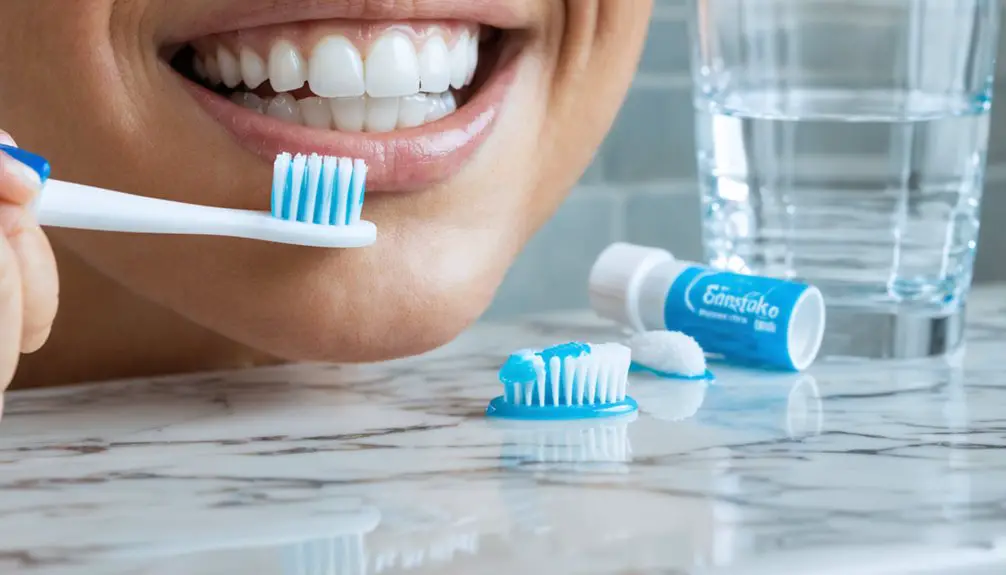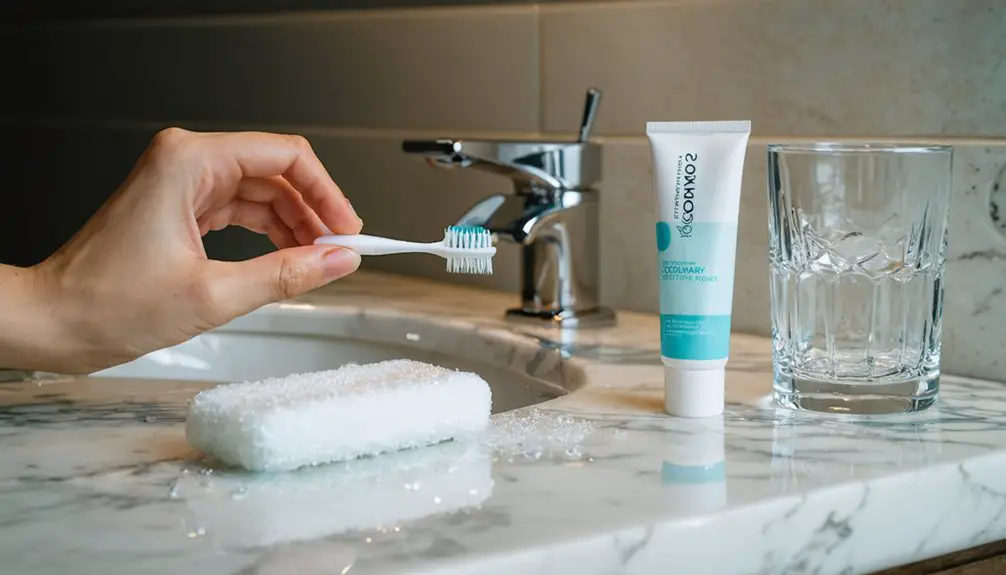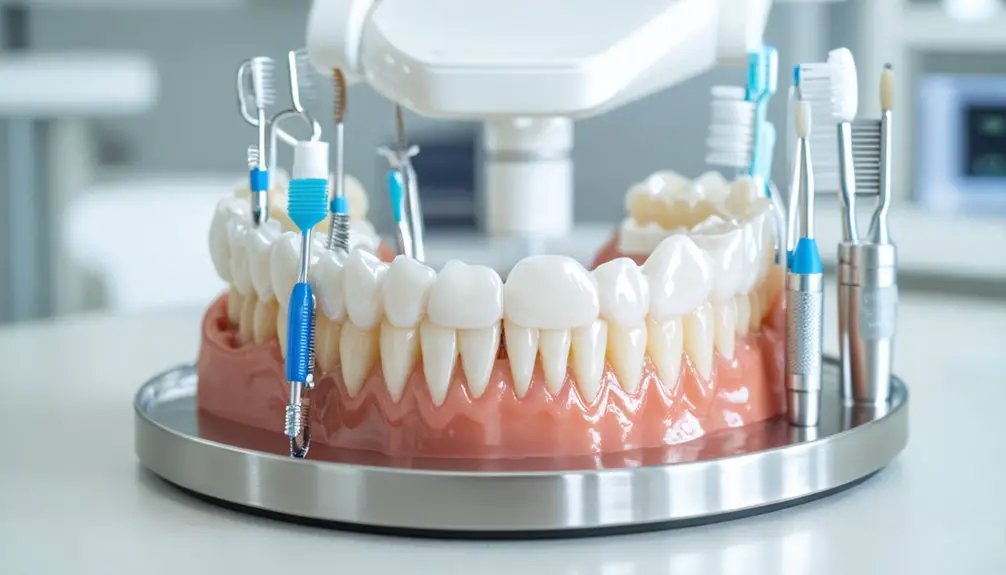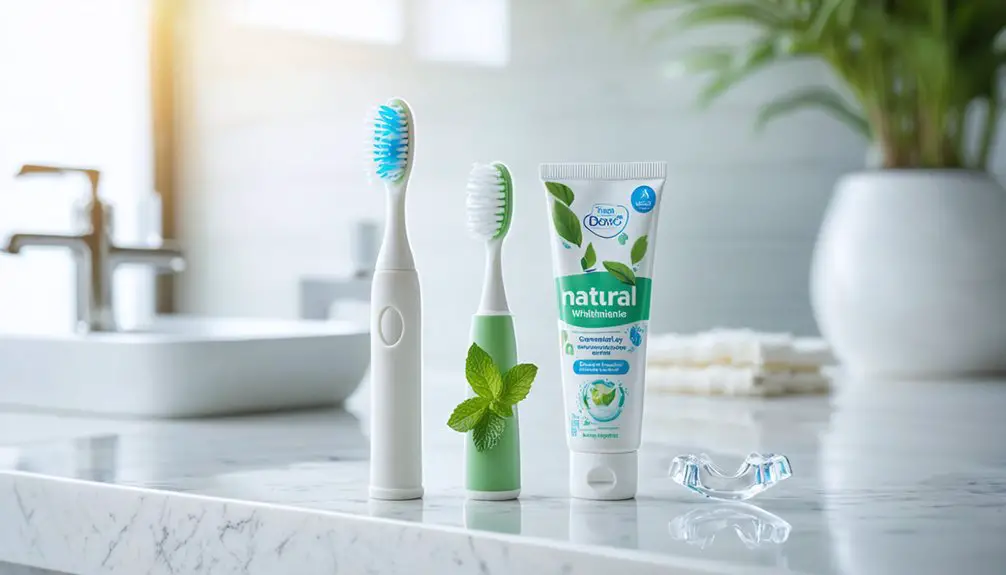You’ll minimize teeth sensitivity during whitening by starting with a professional cleaning and fluoride treatment, using desensitizing products 1-2 weeks before treatment, choosing lower peroxide concentrations, maintaining proper hydration, avoiding temperature extremes in foods and drinks, applying desensitizing gels post-treatment, and monitoring sensitivity levels closely. A thorough approach to sensitivity prevention can help guarantee your whitening experience remains comfortable while delivering peak results.
Key Takeaways
- Use desensitizing toothpaste containing potassium nitrate for 1-2 weeks before whitening treatment to create a protective barrier against sensitivity.
- Choose gradual whitening with lower peroxide concentrations (3-10%) instead of high-concentration treatments for reduced tooth sensitivity.
- Apply professional fluoride treatments before whitening to strengthen tooth enamel and seal dentinal tubules against sensitivity.
- Maintain proper hydration and consume only room-temperature foods and beverages during the first 48 hours after treatment.
- Use desensitizing gels and mouthwash immediately after whitening sessions to minimize discomfort and protect tooth structure.
Professional Fluoride Treatments Before Whitening
When considering teeth whitening treatments, professional fluoride applications serve as an important preparatory step to strengthen your enamel and minimize sensitivity.
These treatments remineralize your tooth structure by replacing lost minerals, creating a protective barrier against the effects of whitening agents.
Your dentist will determine the best fluoride application techniques based on your enamel’s condition and planned whitening intensity.
The enamel remineralization benefits are particularly significant if you have thin enamel or previous dental work.
Through controlled application, fluoride effectively seals dentinal tubules, reducing potential nerve irritation during the whitening process.
The quick and painless treatment can be completed during your regular dental visit before starting your whitening regimen.
Regular use of toothpaste containing 1,000-1,500 ppm fluoride helps maintain the protective effects of professional treatments.
You’ll experience enhanced protection as the treatment strengthens your teeth’s natural defense mechanisms, allowing for a more comfortable whitening experience while maintaining your enamel’s integrity.
Starting With Desensitizing Products Early
Starting a desensitizing regimen several weeks before teeth whitening considerably reduces your risk of treatment discomfort.
Begin using desensitizing toothpaste at least 1-2 weeks prior to whitening, brushing twice daily to minimize nerve excitability in your dentin. You’ll get maximum protection by combining multiple approaches. Clinical research shows that higher peroxide levels can increase sensitivity in up to 78% of patients.
Apply topical gels containing potassium nitrate or fluoride to create a protective barrier that decreases dentin tubule permeability. These products work by interrupting nerve transmission and occluding the tubules that cause sensitivity. Modern minimally invasive techniques help preserve tooth structure while managing sensitivity during whitening procedures.
For enhanced results, incorporate a desensitizing mouthwash containing potassium citrate or strontium chloride into your routine. This multi-product approach is especially beneficial if you’re planning intensive in-office treatments with high-concentration peroxide or have pre-existing sensitivity from gingival recession.
Choosing the Right Whitening Method for Your Teeth
Selecting the ideal teeth whitening method requires careful consideration of your specific needs, sensitivity levels, and desired results. The peroxide concentration and whitening duration vary greatly among different options, directly impacting tooth sensitivity and effectiveness.
- If you’re prone to sensitivity, start with at-home tray systems using lower peroxide concentrations (3-10%) for gentler, gradual results over several weeks. These kits typically cost under $100 for a complete treatment cycle.
- For moderate sensitivity but faster results, consider professional tray-based systems with custom-fitted guards and controlled peroxide levels.
- When sensitivity isn’t a concern and you need dramatic results quickly, professional in-office treatments using 25-40% peroxide can lighten teeth up to 8 shades in one session. Natural alternatives using bio-based whitening agents offer a gentler approach while still providing noticeable results.
- For maintenance with minimal sensitivity risk, use whitening rinses or low-concentration products that work gradually over 3 months.
Smart Food and Drink Choices During Treatment
You’ll need to stay well-hydrated with clear liquids like water and coconut water throughout your whitening treatment to maintain oral comfort and health.
The first 24-72 hours after treatment are most crucial for protecting your newly whitened teeth from stains and sensitivity.
Choosing temperature-neutral foods helps prevent triggering sensitivity while your teeth are more vulnerable during the whitening process.
Including dairy products such as white cheese and plain yogurt provides calcium and proteins that help protect and strengthen your enamel during treatment.
Using a straw for drinking can minimize contact between beverages and your teeth, reducing sensitivity and protecting whitening results.
Hydration Through Clear Liquids
While undergoing teeth whitening treatments, proper hydration through clear liquids plays an essential role in managing sensitivity and supporting enamel health. Your hydration strategies should focus on maintaining consistent moisture levels while avoiding temperature extremes that can trigger discomfort. Adequate saliva flow helps protect teeth against sensitivity and decay during the whitening process. Using soft-bristled toothbrushes after drinking helps maintain gentle cleaning without irritating sensitive areas.
Choose from these liquid types for ideal hydration during treatment:
- Room-temperature water remains the preferred choice, helping remove residual bleaching agents without thermal shock.
- Caffeine-free herbal teas provide gentle hydration without compromising enamel integrity.
- Plain milk offers beneficial calcium while maintaining neutral temperature.
- Clear water rinses support enamel rehydration when timed appropriately after treatment.
Time your liquid consumption carefully, avoiding immediate intake after whitening application to maintain treatment effectiveness.
You’ll achieve better results by gradually introducing hydrating beverages while following your dentist’s specific timing recommendations.
Temperature-Neutral Foods Matter
Temperature control plays an essential role in managing tooth sensitivity during whitening treatments. You’ll need to carefully monitor your food choices, avoiding both hot and cold items that can trigger discomfort by irritating exposed dentin and nerve endings.
Stick to room temperature or slightly warm foods to protect your teeth. Select soft, neutral-textured options like scrambled eggs, mashed potatoes, or plain pasta that won’t require excessive chewing.
These temperature effects are particularly important during the first few days after treatment when sensitivity peaks.
Consider serving white meats like chicken or turkey, and incorporate mild fruits such as bananas.
If you’re preparing meals for someone undergoing whitening, remember that neutral-colored foods not only minimize sensitivity but also help maintain whitening results by preventing staining.
Dairy For Enamel Protection
During teeth whitening treatments, dairy products serve as powerful allies in protecting your enamel and reducing sensitivity. The dairy benefits extend beyond basic nutrition, offering specific protection through calcium, phosphorus, and casein proteins that support enamel remineralization and create defensive barriers against whitening agents.
To maximize dairy’s protective effects during your whitening treatment:
- Consume cheese immediately after whitening sessions to form a protective film over teeth.
- Include vitamin D-fortified milk to enhance calcium absorption and enamel repair.
- Choose natural yogurt to help neutralize acidic conditions in your mouth.
- Opt for dairy products between whitening applications to maintain ideal pH balance.
These strategic dairy choices help safeguard your patients’ enamel while supporting successful whitening outcomes with minimal discomfort.
Proper Pre-Treatment Dental Care Protocol
Establishing proper pre-treatment dental care protocol is essential for maximizing whitening results while minimizing tooth sensitivity. Start by scheduling a professional cleaning to remove tartar buildup and guarantee your tooth surfaces are smooth for best whitening gel contact. This evaluation will also confirm your suitability for the treatment.
For pre-treatment oral hygiene, brush thoroughly with a soft-bristled toothbrush and sensitive toothpaste, followed by careful flossing to remove debris.
You’ll want to avoid over-the-counter whitening products before your professional treatment. Test-fit your whitening trays without gel to guarantee proper fit and comfort.
Remember to maintain proper hydration but avoid acidic foods, drinks, and alcohol-based mouthwashes in the days leading up to your treatment. These steps will help create ideal conditions for effective whitening while protecting your teeth.
Essential Aftercare Steps for Comfort

You’ll need to apply desensitizing products daily after your whitening treatment to minimize discomfort and protect your teeth’s enamel.
Choose room temperature foods and beverages for the first 48 hours, avoiding extreme hot or cold items that could trigger sensitivity.
Monitor your teeth’s healing progress by noting any changes in sensitivity levels, and contact your dentist if discomfort persists beyond 72 hours.
Apply Desensitizing Products Daily
To minimize discomfort after teeth whitening, it’s essential to incorporate desensitizing products into your daily oral care routine.
Studies show that using desensitizing toothpaste containing potassium nitrate can reduce sensitivity by up to 50% when applied consistently during whitening treatments.
For best results during your whitening journey:
- Apply desensitizing toothpaste twice daily, ensuring thorough coverage of all tooth surfaces.
- Use specialized desensitizing agents prescribed by your dentist alongside bleaching gels.
- Continue using desensitizing products for at least two weeks post-treatment.
- Monitor your sensitivity levels and report any unusual changes to your dental professional.
Remember that consistency is key – maintaining a regular desensitizing routine will help protect your patients while achieving their desired whitening results.
Gentle Temperature Food Choices
Proper food temperature management plays an essential role in minimizing tooth sensitivity after whitening treatments. You’ll want to avoid extreme temperatures that can trigger discomfort in your newly whitened teeth. Stick to lukewarm or room-temperature foods and beverages for the first 48 hours post-treatment.
Choose gentle temperature foods with soft textures, such as plain yogurt, mashed potatoes, and steamed chicken. These options reduce mechanical stress on sensitive enamel while providing necessary nutrition.
Bananas and sliced apples offer safe fruit alternatives, as they’re low in acid and won’t irritate your teeth. Remember to drink room-temperature water throughout the day to help rinse away food particles and promote healing.
Monitor Healing and Recovery
Beyond managing food temperatures, successful teeth whitening requires careful monitoring of the healing process.
To effectively monitor healing and implement proper recovery techniques, you’ll need to track specific indicators during the first 72 hours post-treatment.
- Monitor tooth sensitivity levels, which typically peak within 48-72 hours, and use over-the-counter pain relief if needed.
- Assess gum tissue for signs of irritation, maintaining gentle brushing with a soft-bristled toothbrush.
- Track your teeth’s color stabilization process, which occurs during the initial 48-hour period.
- Document any persistent sensitivity or discomfort to report to your dental professional.
Remember to schedule follow-up appointments to evaluate your enamel health and discuss potential touch-up treatments once the initial recovery period has passed.
Managing Temperature Sensitivity Post-Treatment

While teeth whitening can effectively brighten your smile, managing temperature sensitivity in the first 48 hours after treatment is crucial for your comfort.
To minimize sensory discomfort, avoid consuming hot drinks like coffee or tea, and steer clear of cold foods such as ice cream. If you need cold beverages, use a straw to reduce direct contact with your teeth.
Protect your teeth from temperature fluctuations by sticking to room-temperature foods and drinks until sensitivity subsides.
When brushing, use lukewarm water and wait at least 30 minutes after eating.
Consider using desensitizing toothpaste containing potassium nitrate before and after treatment to block nerve signals.
For enhanced protection, apply desensitizing gel during the initial 48-hour period, and maintain these practices until sensitivity resolves.
Frequently Asked Questions
How Long Should I Wait Between Whitening Treatments to Avoid Increased Sensitivity?
You’ll need 6 months between professional whitening treatments and 1-2 weeks between at-home sessions. Consider your sensitivity duration after each treatment to adjust whitening frequency accordingly.
Can Certain Medications Make My Teeth More Sensitive During Whitening Procedures?
Yes, certain medication types like antibiotics, antihistamines, and antihypertensives can increase your teeth’s sensitivity levels during whitening by affecting your enamel integrity and dentin exposure. Tell your dentist about medications.
Does Having Dental Work Like Crowns Affect Whitening Sensitivity Differently?
Yes, you’ll experience heightened sensitivity with crowns during whitening since dental work can allow deeper penetration of bleaching agents around restoration margins, causing more intense nerve irritation than natural teeth.
Are Natural Whitening Alternatives Less Likely to Cause Tooth Sensitivity?
You’ll typically experience less sensitivity with natural home remedies compared to whitening gels, but they’re also less effective. Oil pulling and food-based methods offer the gentlest approach for sensitive teeth.
Why Do Some People Experience More Teeth Sensitivity Than Others During Whitening?
You’ll experience varying sensitivity due to genetic factors that affect your enamel thickness, nerve sensitivity thresholds, and dentin tubule density, making your teeth naturally more reactive to whitening agents.
References
- https://eckerfamilydental.com/how-to-reduce-tooth-sensitivity-during-whitening-treatment/
- https://familydentistchandler.com/how-to-avoid-teeth-sensitivity-after-whitening/
- https://balanceddentalstudio.com/10-ways-to-soothe-teeth-sensitivity-after-whitening/
- https://www.scottgreenhalghdds.com/blog/10-tips-for-dealing-with-sensitivity-after-teeth-whitening
- https://www.sensodyne.com/en-us/oral-health-tips/whitening-sensitive-teeth/how-to-help-sensitive-teeth-after-whitening/
- https://www.chelmsforddental.com.au/does-fluoride-whiten-your-teeth/
- https://www.southernctdental.com/blog/everything-you-should-know-about-fluoride-treatments
- https://www.turnagaindental.com/blog/the-benefits-of-professional-tooth-whitening/
- https://julingtondental.com/benefits-of-professional-teeth-whitening/
- https://www.regencysquaredental.com/benefits-of-professional-fluoride-treatments-for-adults-kids/



